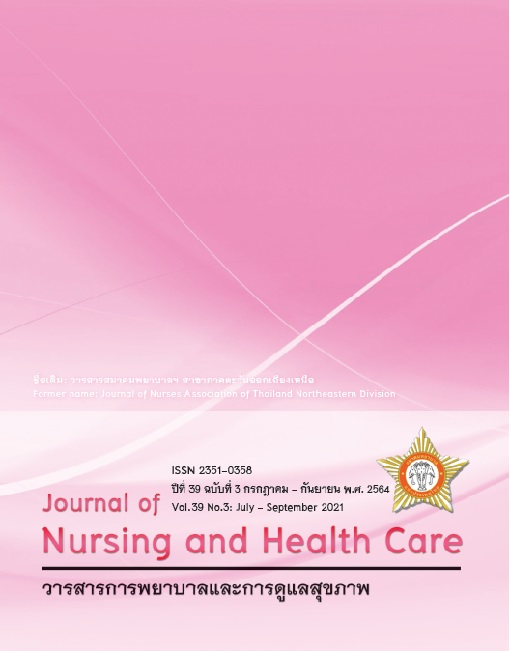ความสามารถของพยาบาลในการประเมิน และจัดการอาการปวดในผู้ป่วยมะเร็งระยะลุกลาม
คำสำคัญ:
ความสามารถของพยาบาล, การประเมินอาการ, การจัดการอาการ, อาการปวด, มะเร็งระยะลุกลามบทคัดย่อ
การวิจัยเชิงพรรณนาเปรียบเทียบนี้ มีวัตถุประสงค์เพื่อศึกษาการรับรู้ความสามารถของพยาบาลในการประเมินและจัดการอาการปวดในผู้ป่วยมะเร็งระยะลุกลาม เปรียบเทียบความสามารถในการประเมินและจัดการอาการปวดตามปัจจัยพื้นฐาน กลุ่มตัวอย่างคือ พยาบาลที่ดูแลผู้ป่วยมะเร็งที่รักษาในโรงพยาบาลจุฬาภรณ์จำนวน 85 คน เก็บข้อมูลโดยใช้แบบบันทึกข้อมูลส่วนบุคคล และแบบสอบถามการรับรู้ความสามารถในการประเมินและจัดการอาการปวด วิเคราะห์ข้อมูลโดยใช้ Independent t-test/Mann-Whiney U test, One-way ANOVA/Kruskal Wallis
ผลวิจัย พบว่า พยาบาลรับรู้ความสามารถในการประเมินและจัดการอาการปวดในผู้ป่วยมะเร็งระยะลุกลามด้านความรู้ ด้านการปฏิบัติและโดยรวม ระดับปานกลาง พยาบาลที่มีการศึกษาระดับปริญญาโทมีความสามารถด้านการปฏิบัติและโดยรวมสูงกว่าพยาบาลที่มีการศึกษาระดับปริญญาตรี (p<.05) พยาบาลที่ผ่านการอบรมการดูแลผู้ป่วยมะเร็งระยะลุกลามมีความสามารถโดยรวมสูงกว่าพยาบาลที่ไม่ผ่านการอบรม (p<.05) พยาบาลที่มีประสบการณ์การดูแลผู้ป่วยมะเร็งต่างกัน มีความสามารถด้านการปฏิบัติต่างกัน โดยพยาบาลที่มีประสบการณ์ > 5 ปี มีความสามารถด้านการปฏิบัติสูงกว่าพยาบาลที่มีประสบการณ์ < 2 ปี (p<.05)
การวิจัยนี้เสนอแนะให้มีการอบรมการประเมินและจัดการอาการปวดอย่างต่อเนื่องโดยเน้นการจัดการอาการปวดโดยไม่ใช้ยาร่วมด้วย ตลอดจนสนับสนุนการทำวิจัยแบบ R2R เพื่อประเมินและจัดการอาการปวดในผู้ป่วยมะเร็งระยะลุกลามในหลากหลายรูปแบบ
Downloads
เอกสารอ้างอิง
1. American Cancer Society. Advanced cancer [Internet]; 2018 [cited 2021 May 26]. Available from https://www.cancer.org/treatment/understanding-your-diagnosis/advancedcancer/what-is.html
2. Napa T, Suchira C, Bualuang S. Symptom Experiences and Symptom Management in Patients with Advanced Cancer Receiving Palliative Care. Rama Nurs J 2015; 21(1): 82-95. [in Thai]
3. Benjamas P, Nam-oy P, Sirikorn K, Saengrawee T, Pornpimol L, Kanitha H. Symptom Experience and Symptom Management of Patients with Advanced Cancer and Family Caregivers. APHEIT Journal of Nursing and Health 2019; 1(1): 50-66. [in Thai]
4. Srirat M, Chatchai Sirichayanugul, T. Common symptoms and needs of pre-discharge advanced-stage cancer patients: A case-study at phrae hospital, Thailand. Thai Cancer Journal 2013; 33(4): 132-45. [in Thai]
5. Stark LL, Tofthagen C, Visovsky C, McMillan SC. The symptom experience of patients with cancer. Journal of Hospice & Palliative Nursing 2012; 14(1): 61-70.
6. Vidakovic MT, Graeff AD, Voest EE, Teunissen SCCM. Symptoms tell it all: A systematic review of the value of symptom assessment to predict survival in advanced cancer patients. Critical Reviews in Oncology/Hematology 2012; 84: 130–48.
7. Lancker AV, Velghe A, Hecke AV, Verbrugghe M, Noortgate, NVD, Gr ypdonck M, Beeckman, D. Prevalence of symptoms in older cancer patients receiving palliative care: A systematic review and meta-analysis. Journal of Pain and Symptom Management 2014; 47(1): 90-104.
8. Apinya P, Atitaya Y. Pain symptom in cancer patients. HOCC-PSU [internet]; 2013 [cited 2021 May 26]. Available from: http://hocc.medicine.psu.ac.th/files/khowledge/04april_2013-p26-27.pdf [in Thai]
9. Oncology nurse generalist competencies. [internet]; 2016 [cited 2021 May 26]. Available from: https://www.ons.org/sites/default/files/Oncology%20Nurse%20Generalist%20Competencies%202016.pdf
10. BC Cancer Agency. Symptom management guidelines. [internet]; 2018 [cited 2021 May 26]. Available from: http://www.bccancer.bc.ca/healthprofessionals/clinicalresources/nursing/symptom-management
11. National Comprehensive Cancer Network. Palliative care clinical practice guideline. [internet]; 2017 [cited 2021 May 26]. Available from: https://www.nccn.org/professionals/physician_gls/pdf/palliative.pdf
12. Bouya S, Balouchi A, Maleknejad A, Koochakzai M, AlKhasawneh E, Abdollahimohammad A. Cancer pain management among oncology nurses: knowledge, attitude, related factors, and clinical recommendations: A systematic review. Journal of Cancer Education 2019; 34: 839-46. doi: 10.1007/s13187-018-1433-6
13. Kassa RN, Kassa GM. Nurses’ attitude, practice and barriers toward cancer pain management, addis ababa, ethiopia. An Open Access Journal 2014; 6(12): 483-7.
14. Nega R, Tachbele E, Kassa GM. Cancer pain and its management: Knowledge of nurses at selected health institutions, offering cancer treatment in addis ababa, Ethiopia, 2013, Journal of Pain & Relief 2014; 3(2): 1-6. doi: 10.4172/2167-0846.1000137
15. Omran S, Qadire AM, Ali AN, Hayek AFM. Knowledge and attitudes about pain management: A comparison of oncology and non-oncology Jordanian nurses. Nursing and Health 2014; 2(4): 73-80.
16. Salim NA, Faisal WA, Hussain H. Nurses approach toward cancer pain management in oncology unit of Dubai Hospital, Dubai Health Authority in 2017. Journal of Nursing & Patient Care 2018; 3: 57. doi: 10.4172/2573-4571-C6-030
17. Tipthaporn P, Wongchan P, Aranya C. Professional Nurses’ Perceived Self-Efficacy and Practices in Non-Pharmacologic Pain Relief Techniques for Cancer Patients. The Thai Journal of Nursing Council 2003;18(3): 65-85.
18. Cancer Care Ontario. Symptom management algorithm pain in adults with cancer. [internet]; 2010 [cited 2021 May 26]. Available from: https://www.cancercareontario.ca/en/symptom-management
19. Sumran J, Rachanee N, Ampaporn N. Nurses’ Ability to Assess and Manage Symptoms of Patients with Advanced Cancer. The Journal of Faculty of Nursing Burapha University 2021; 29(1): 25-36. [in Thai]
20. Bloom BS, Madaus GF, Hastings JT. Handbook on Formative and Summative Evaluation of Student Learning. New York: McGraw-Hill; 1971.
21. Pai RR, Ongole R. Nurses’ Knowledge and education about oral care of cancer patients undergoing chemotherapy and radiation therapy. Indian Journal of Palliative care 2015; 12(2): 225-30.
22. Tranmer R, Boyd L, Johnson T, Howlett B, Bowen D, Peterson T. National Survey of oncology members’ knowledge, education, and patient management regarding oral care in cancer therapy. Health and Interprofessional Practice 2013; 2(1): 1-13.



